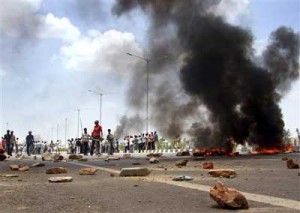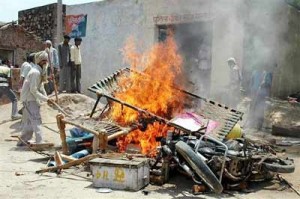The mobs are led by leaders, who incite worst passions but invariably disappear from the scene once violence breaks out-only to return to do breast-beating against even the minimal response of the security forces. In that they are joined by a large section of the media. It is only the elements of misguided mob who are injured or killed. Nothing ever happens to leaders. They are seldom arrested, questioned and held accountable for causing inconvenience to the public and loss of goverment property despite clear laws as enunciated by a judgement of the Kerala High Court.
The Gujjar agitation caused a cumulative loss of hundreds of crores to the state. Police deployment against mobs is manpower intensive. The growing phenomenon of mob culture imposes huge manpower constraints on the police and therefore detracts it from its normal law and order duties. There is now the danger of terrorists operating in the cover of mobs to pursue their own externally and internally abetted agenda.
Efficacy of the Police
The police was evidently lacking in anti-riot resources, training and direction in dealing with the Gujjar agitators. Since the National Security Advisor maintains that our most serious security problems are internal, it is therefore incumbent that our internal security apparatus including the intelligence be adequately bolstered to meet threats posed by unruly mobs. The Gujjar agitation was anything but spontaneous. Rather, it had the hallmarks of a well-deliberated and orchestrated plan indicative of a military mind.
 The intelligence apparatus of both the center and the state appeared to have no clue about it. It also reflects on the intelligence cooperation and intelligence sharing mechanisms between the two. A little too soon the police found itself overwhelmed, and para-military forces and army contingents had to be deployed, however, the situation remained intransigent.
The intelligence apparatus of both the center and the state appeared to have no clue about it. It also reflects on the intelligence cooperation and intelligence sharing mechanisms between the two. A little too soon the police found itself overwhelmed, and para-military forces and army contingents had to be deployed, however, the situation remained intransigent.
Army Deterrence
The most worrisome part of the entire Gujjar agitation was the undermining of deterrence value of the army-the country’s ultimate recourse for internal security. Army contingents conducted flag marches all over the impacted areas but of no avail. Use of minimal force is most laudable and desirable in dealing with such situations, but our decision-makers need to realise that the army is deployed for effect. The para-military forces and the army were seen to be reluctant in exercising even that minimum inescapable force, not of their own voilition, but because of prevarication of the decision-makers.
While in this particular case, we may draw the satisfaction that the agitation has temporarily been resolved due to other factors, it may not be the case in future. The agitatiors were led by a former army officer who had correctly understood the functional limitations of the army contingents that were deployed.
Insensitivity Towards Security Personnel
Provoking the police for retaliation has become the modus-operandi for most leaders of mobs. Colonel K S Bainsla, the leader of the Gujjar agitators did not seem to be averse to it. A mob in a particular area was provoked to lynch two unarmed policemen in order to invite greater use of force by the police. Such leaders thrive on the deaths of their own brethren. The media barring some exceptions did not have even a word of sympathy for the two murdered policemen deployed on a legitimate duty.
Military personnel, particularly officers, who choose to make a career in politics or public life after retirement, by propagating divisive themes for quick rise, are not true to their oath and fidelity to their alma mater. They in fact, never deserved to be in the armed forces.
This is a phenomenon being witnessed all over the country. The lives of security personnel deployed in insurgency and other tasks are considered to be expendable. No security forces can perform well without a degree of empathy and understanding of the normal public. Absence of it demoralises them and makes them cynical.
Invidious Themes
Every second day in India, a new invidious theme is invented by politicians. The flawed premise and logic of such themes can be judged by their un-productivity and short life spans. Caste based organisations have no basis to exist, and the segment of population the leaders claim to represent have little commonality, as they belong to different social, linguistic and cultural milieu in this large diverse country. Most army officers are quite aware about the stark differences between Gujjars in Rajasthan, Himachal, J&K, Uttar Pradesh and Andhra Pradesh.
 In the present divisive scenario, the armed forces are an island of national integration and cohesion. It is the best example of unity through diversity rather than unity in-diversity. Most regiments in the Indian Army are based on particular ethnic mix. The ethnic pride however is fashioned into organisational pride by sheer strength of institutional ethos, culture and training. Many units that have troops of more than one religious extraction have an integrated religious complex. ,
In the present divisive scenario, the armed forces are an island of national integration and cohesion. It is the best example of unity through diversity rather than unity in-diversity. Most regiments in the Indian Army are based on particular ethnic mix. The ethnic pride however is fashioned into organisational pride by sheer strength of institutional ethos, culture and training. Many units that have troops of more than one religious extraction have an integrated religious complex. ,
The fact cannot be ignored that the manpower in the armed forces are drawn from the society as such. Constant harping on invidious themes, therefore ultimately impacts the armed forces though the process may be slow and subtle. Military personnel, particularly officers, who choose to make a career in politics or public life after retirement, by propagating divisive themes for quick rise, are not true to their oath and fidelity to their alma mater. They in fact, never deserved to be in the armed forces. In this context, one is reminded of the 1984 elections in which Lt Gen (Retd) S K Sinha, now the Governor of J&K, was one of the candidates in Patna Constituency. Some people of a particular community had been killed as a result of violence.
Do mobs and their leaders enjoy complete legal immunity and can operate with impunity?
Gen Sinha was advised by few of his election managers that he must visit the locality, as that was the best opportunity to make impression on that community. He flatly refused to do so, saying that caste and religion should not be exploited for narrow electoral gains. The moot question is where does this invidious politics end ? The Supreme Court had recently observed that the politics of reservation may lead to caste wars.
The situation in Rajasthan during the recent agitation was just degenerating into that. If anybody suggests that the armed forces will remain immune from such developments in civil society, he is not being honest or sensitive enough. Has it been analysed that what caste based reservations could do to the organisational imperatives and culture of the armed forces ? For instance, if a General’s children by virtue of their father’s caste extraction were entitled to reservation, and not the children of his subordinates (including JCOs and ORs)-will the General have the requisite moral superiority to command them ?
Conclusion
Our decision-makers must, therefore seriously ponder over following :
- Is insurgency and instability moving from the periphery to the core of India ?
- Was this the last time that Delhi was under siege ?
- Do mobs and their leaders enjoy complete legal immunity and can operate with impunity?
- Do we have contingency plans to deal with mob violence ?
- Have we learnt anything from the anti-Sikh Riots of 1984 ?
- Are we doing anything to purge India of mob culture ?
- Is internal security hostage to party politics ?
- What is our threshold level considering that the capital was under siege for nearly four days?
- What is the guarantee that the agitators will not be allowed to threaten sensitive installations and VIPs in the capital and elsewhere in future?
- Has the deterrence value of the army denuded considering that the Army conducted flag marches in Rajasthan and yet the agitators did not melt away ?
- Are the armed forces sensitive about the impact of divisive politics on its organisational cohesion and efficiency?
All photographs courtesy to sify.com




